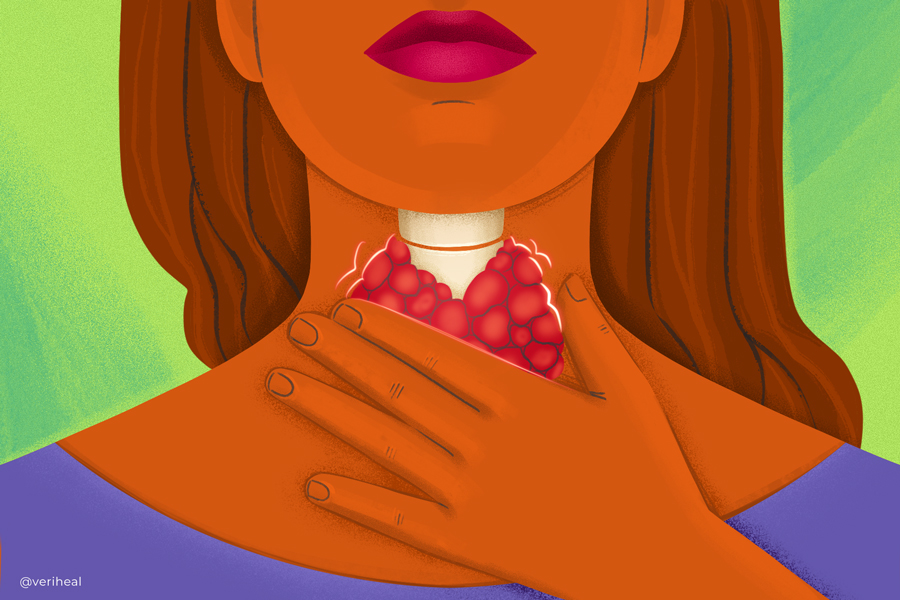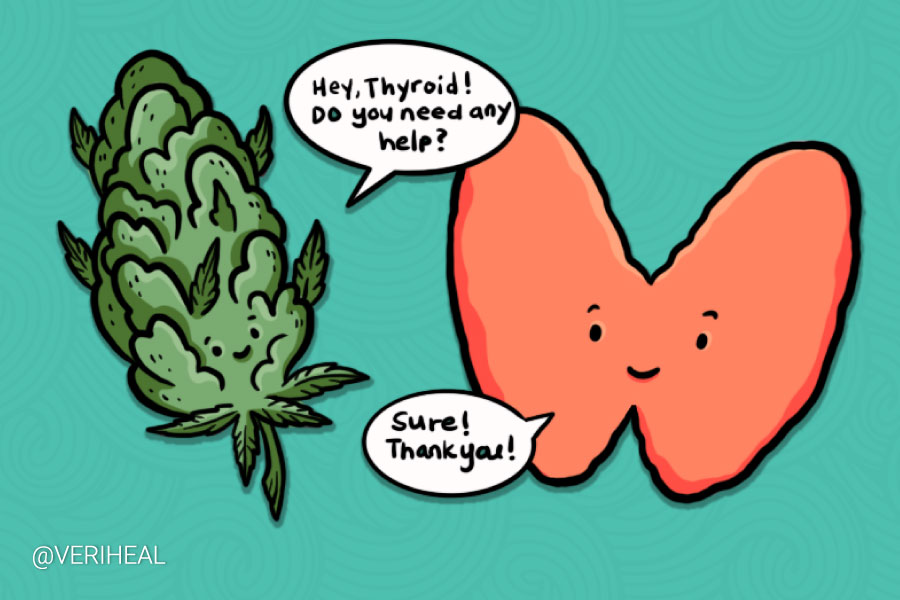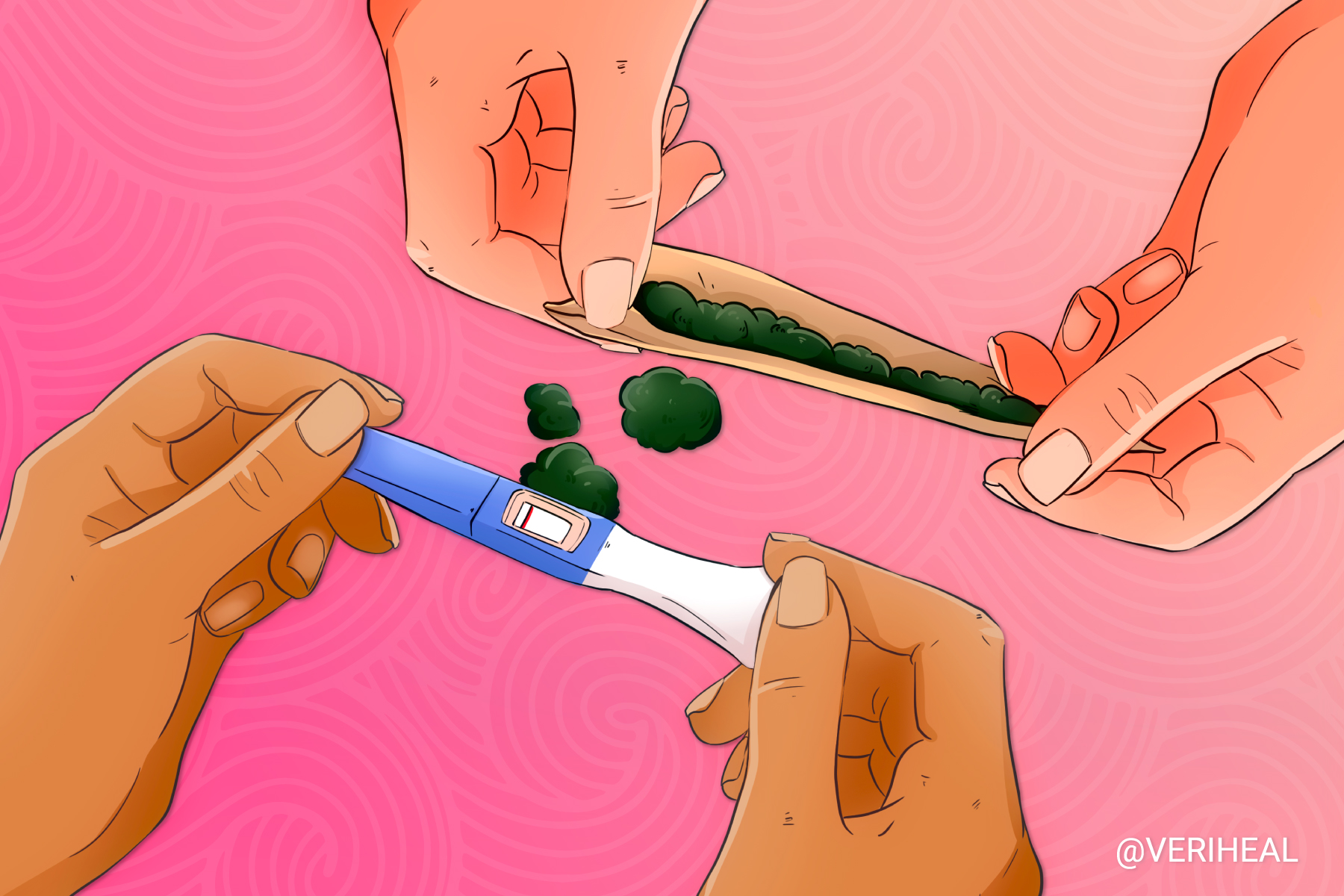Thyroid Health: Can Medical Marijuana Help Plummer Disease?

Plummer disease is a thyroid disorder that causes the thyroid gland to produce too much of the thyroid hormone. If left untreated, this excess of thyroid hormone can lead to serious health risks.
Cannabis may be able to help combat the symptoms of Plummer disease, increasing your quality of life. Read on to learn the latest research on the relationship between cannabis and the thyroid.
What is Plummer Disease?
Plummer disease is a thyroid disorder that causes hyperthyroidism. It’s the second most common cause of hyperthyroidism after Graves disease (7).
Hyperthyroidism happens when the thyroid gland produces too much thyroid hormone. This hormone is more than what the body needs to work properly (22).
Plummer disease is characterized by the thyroid gland growing bigger, which is called a goiter. This goiter can make a visible lump on the person’s neck.
If the goiter has one or more active nodules, it’s called a toxic nodular goiter (TCG). The treatment options depend on whether the patient has one or several nodules growing in the goiter (18).
Symptoms of Plummer Disease
The symptoms of Plummer disease reflect those of hyperthyroidism, plus an enlarged thyroid gland. These symptoms include (22):
- Irritability or nervousness
- Fatigue
- Muscle weakness
- Difficulties sleeping
- Irregular heartbeat or palpitations
- Weight loss
- Mood swings
- Tremors
- Frequent bowel movements
- Sensitivity to heat, heat intolerance
- Increased appetite (18)
The physical changes of hyperthyroidism can be subtle but include (18):
- Enlarged thyroid gland with one or more soft, smooth, mobile nodules
- Breathing or speaking difficulties, hoarse voice
- Increased opening space between the eyelids (palpebral fissures)
- Moist and smooth skin
- Fast or racing heartbeat
- Weakness of the proximal (closer to the body) muscles
- Brisk reflexes and movement (7)
Cannabinoids and Hyperthyroidism
Cannabis may have the potential to impact Plummer disease.
Cannabis has around 150 natural components called cannabinoids (4). Two important cannabinoids are cannabidiol (CBD) and Δ9-tetrahydrocannabinol (THC). These cannabinoids affect our bodies through something called the endocannabinoid system (ECS).
The ECS is made up of special substances in our body that get activated when cannabis interacts with certain receptors called CB1 and CB2. These receptors can be found all over our body, like in our brain, skin, and organs including the thyroid.
When these receptors get activated, they can change the levels of certain substances in our bodies. The receptors help our body control inflammation and how we feel chronic pain and acute pain.
The ECS also has a direct effect on a part of our brain called the pituitary gland. A research paper from 2018 showed that when the ECS and pituitary gland are activated, it can stop the release of a hormone called thyrotropin. Thyrotropin is a hormone that tells the thyroid to release other hormones.
So when the ECS is activated in the pituitary gland, it can stop the release of thyroid hormones (2).
Therefore, cannabis has the potential to impact Plummer disease. When cannabis is consumed, the cannabinoids interact with the body and can potentially stop the release of other hormones, including the thyroid hormone.
Can Cannabis Help Thyroid Conditions?
Limited research indicates that cannabinoids may have a beneficial impact on certain thyroid disorders like Hashimoto’s disease and Grave’s disease (8). These conditions are classified as autoimmune diseases, and medical marijuana has shown immunosuppressive effects that can help reduce the severity of symptoms.
Plummer disease is not considered an autoimmune condition. However, there is a possibility that using cannabinoids to lower thyroid hormones could potentially be helpful in reducing hyperthyroidism (2). This idea needs further investigation through large and controlled clinical trials to fully understand its effectiveness.
Apart from the anti-inflammatory effects of CBD mentioned earlier, cannabinoids have also been discovered to have immunosuppressive properties by inducing cell death in T-lymphocytes and macrophages (15). These immune cells are responsible for fighting off harmful substances in the body.
However, in autoimmune conditions, they mistakenly attack healthy tissues, leading to inflammation. Increasing the rate of cell death in these immune cells can help reduce inflammation by lowering their numbers and activity against healthy tissues.
Recommendations for Hyperthyroidism and Cannabis
Although there is evidence suggesting that cannabis could help with thyroid disorders, there is currently no clinical proof to definitively say that it can effectively treat patients with these diseases.
According to CRX Magazine, full-spectrum or full-plant medical cannabis products are more likely to be beneficial for patients with thyroid ailments (8). The natural compounds in cannabis work together in what is called the “entourage effect,” meaning that cannabinoids and terpenes are more effective when combined rather than used individually.
There are some research studies indicating a connection between cannabis use and lower levels of Thyroid Stimulating Hormone (TSH) in blood tests (5). Scientists believe that this decrease might be due to the cannabinoids directly affecting the pituitary gland, which then leads to a decreased release of thyrotropin (2).
However, it’s worth noting that individuals with Plummer disease experience increased TSH levels, rather than the lower levels that could be linked to cannabis use.
Forms of Medical Cannabis for Plummer Disease
There are several different cannabis products that can be purchased through your local medical cannabis dispensary. It is important to do some experimenting and see what products work well for easing your symptoms.
Some popular medical cannabis products include:
- Cannabis flower
- Tinctures
- Oils
- Topicals
- Edibles
- Vape cartridges
- Vaginal & rectal suppositories
Many patients experience health benefits from using CBD-only products including CBD oils and topical products. CBD does not produce a psychoactive side effect or impairment unlike THC, the most well-known ingredient in medical marijuana.
Talking to your Provider
It is important to see your primary care doctor right away if you suspect that you have thyroid problems. Hyperthyroidism can lead to other serious health conditions if left untreated. Some of these risks include (22):
- Developing osteoporosis
- Fertility problems
- Pregnancy complications include high blood pressure, miscarriage, premature birth, and low birth weight
- Vision damage including, double vision, eye sensitivities, or vision loss
- Irregular heartbeat, An irregular heartbeat can lead to stroke, arrhythmias, heart failure, and other serious heart problems
Before using medical cannabis to combat symptoms of Plummer disease, talk to your provider about your medical history as well as any medications you’re currently taking. Cannabis interacts with different medications in different ways, so being transparent about your cannabis use is essential to establishing an effective medical care routine.
Note: Veriheal does not intend to give this as professional medical advice. Do not attempt to self-diagnose or prescribe treatment based on the information provided on this page. Always consult a physician before making any decision on the treatment of a medical condition.
1. Bonnet, U. (2017). Chronic Cannabis Abuse and Thyroid Function. Handbook of Cannabis and Related Pathologies, 461-465 .https://www.sciencedirect.com/science/article/pii/B9780128007563000545
2. Borowska, M., Czarnywojtek, A., Sawicka-Gutaj, N., Woliński, K., Płazińska, M. T., Mikołajczak, P., & Ruchała, M. (2018). The effects of cannabinoids on the endocrine system. Endokrynologia Polska, 69(6), Article 6. https://journals.viamedica.pl/endokrynologia_polska/article/view/EP.a2018.0072
3. Bryant, L. M., Daniels, K. E., Cognetti, D. M., Tassone, P., Luginbuhl, A. J., & Curry, J. M. (2018). Therapeutic cannabis and endocannabinoid signaling system modulator use in otolaryngology patients. Laryngoscope Investigative Otolaryngology, 3(3), 169–177. https://onlinelibrary.wiley.com/doi/full/10.1002/lio2.154
4. Citti, C., Linciano, P., Russo, F., Luongo, L., Iannotta, M., Maione, S., Laganà, A., Capriotti, A. L., Forni, F., Vandelli, M. A., Gigli, G., & Cannazza, G. (2019). A novel phytocannabinoid isolated from Cannabis sativa L. with an in vivo cannabimimetic activity higher than Δ9-tetrahydrocannabinol: Δ9-Tetrahydrocannabiphorol. Scientific Reports, 9(1), Article 1. https://www.nature.com/articles/s41598-019-56785-1/
5. Farasat, S., & Chang, A. (2022). PSAT327 Can Cannabis Use Lead to Central Hypothyroidism. Journal of the Endocrine Society, 6(Suppl 1), A825. https://www.ncbi.nlm.nih.gov/pmc/articles/PMC9627571/
6. Kang, A. S., Grant, C. S., Thompson, G. B., & van Heerden, J. A. (2002). Current treatment of nodular goiter with hyperthyroidism (Plummer disease): Surgery versus radioiodine. Surgery, 132(6), 916-923. https://www.sciencedirect.com/science/article/abs/pii/S0039606002002349
7. Khalid, N., & Can, A. S. (2022). Plummer Disease. In StatPearls. StatPearls Publishing. https://www.ncbi.nlm.nih.gov/books/NBK565856/
8. Kyle, E. (2021). Cannabis & Thyroid Health. CRx Magazine. Retrieved January 30, 2023, from https://www.crxmag.com/issues/2021/summer/cannabis-and-thyroid-health.shtml
9. Lakiotaki, E., Giaginis, C., Tolia, M., Alexandrou, P., Delladetsima, I., Giannopoulou, I., Kyrgias, G., Patsouris, E., & Theocharis, S. (2014). Clinical Significance of Cannabinoid Receptors CB1 and CB2 Expression in Human Malignant and Benign Thyroid Lesions. https://www.ncbi.nlm.nih.gov/pmc/articles/PMC4619873/
10. Mahajan, A., Ghaznavi, S. A., Lithgow, K., & Paschke, R. (2019). Toxic Multinodular Goiter. Encyclopedia of Endocrine Diseases (Second Edition), 730-736. https://www.sciencedirect.com/science/article/pii/B9780128012383960380
11. Malhotra, S., Heptulla, R. A., Homel, P., & Motaghedi, R. (2017). Effect of marijuana use on thyroid function and autoimmunity. Thyroid, 27(2), 167–173. https://www.liebertpub.com/doi/full/10.1089/thy.2016.0197
12. Meah, F., Lundholm, M., Emanuele, N., Amjed, H., Poku, C., Agrawal, L., & Emanuele, M. A. (2021). The effects of cannabis and cannabinoids on the endocrine system. Reviews in Endocrine and Metabolic Disorders, 23(3), 401–420. https://link.springer.com/article/10.1007/s11154-021-09682-w
13. Miller LK, Devi LA. The highs and lows of cannabinoid receptor expression in disease: mechanisms and their therapeutic implications. Pharmacol Rev. 2011 Sep;63(3):461-70. Epub 2011 Jul 13. https://www.ncbi.nlm.nih.gov/pmc/articles/PMC3141881/
14. Muzaffar, A., Ullah, S., Subhan, F., Nazar, Z., Hussain, S. M., Khuda, F., Khan, A., Khusro, A., Sahibzada, M. U., Albogami, S., M., A., Emran, T. B., Javed, B., & Ali, J. (2021). Clinical Investigation on the Impact of Cannabis Abuse on Thyroid Hormones and Associated Psychiatric Manifestations in the Male Population. Frontiers in Psychiatry, 12. https://www.frontiersin.org/articles/10.3389/fpsyt.2021.730388/full
15. Nagarkatti, P., Pandey, R., Rieder, S. A., Hegde, V. L., & Nagarkatti, M. (2009). Cannabinoids as novel anti-inflammatory drugs. Future medicinal chemistry, 1(7), 1333–1349. https://www.ncbi.nlm.nih.gov/pmc/articles/PMC2828614/
16. Shi, Y., Zou, M., Baitei, E. Y., Alzahrani, A. S., Parhar, R. S., Al-Makhalafi, Z., & Al-Mohanna, F. A. (2008). Cannabinoid 2 receptor induction by IL-12 and its potential as a therapeutic target for the treatment of anaplastic thyroid carcinoma. Cancer gene therapy, 15(2), 101–107. https://pubmed.ncbi.nlm.nih.gov/18197164/
17. Tomko, A. M., Whynot, E. G., Ellis, L. D., & Dupré, D. J. (2020). Anti-Cancer Potential of Cannabinoids, Terpenes, and Flavonoids Present in Cannabis. Cancers, 12(7). https://www.ncbi.nlm.nih.gov/pmc/articles/PMC7409346/
18. Toxic Nodular Goiter: Practice Essentials, Pathophysiology, Etiology. (n.d.). Retrieved March 13, 2023, from https://emedicine.medscape.com/article/120497-overview
19. Trivedi, M.K., Mondal, S. & Jana, S. Cannabidiol improves thyroid function via modulating vitamin D3 receptor in vitamin D3 deficiency diet-induced rat model. J Food Sci Technol 59, 3237–3244 (2022). https://link.springer.com/article/10.1007/s13197-022-05492-3
20. Volpe, K. D. (2016, August 30). Is there a link between thyroid cancer and hyperthyroidism? – endocrineweb. Endocrine Web for Healthcare Professionals. Retrieved January 30, 2023, from https://pro.endocrineweb.com/research-updates/thyroid-disorders/there-link-between-thyroid-cancer-hyperthyroidism
21. U.S. National Library of Medicine. (n.d.). Hyperthyroidism | graves’ disease | overactive thyroid. MedlinePlus. Retrieved January 30, 2023, from https://medlineplus.gov/hyperthyroidism.htm









